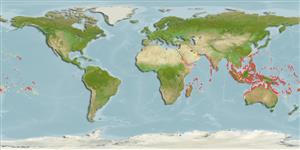Gastropoda |
Littorinimorpha |
Strombidae
Environment: milieu / climate zone / depth range / distribution range
Ecology
Benthic; depth range 0 - 24 m (Ref. 349). Tropical; 29°N - 29°S, 33°E - 126°W
Indo-Pacific: from East Africa, India, Sri Lanka, Andaman and Nicobar Islands, east to southeast Asia and Australia, as far east to French Polynesia and north to Japan. Subtropical and tropical.
Length at first maturity / Size / Weight / Age
Maturity: Lm ? range ? - ? cm Max length : 29.0 cm SHL male/unsexed; (Ref. 349); common length : 18.0 cm SHL male/unsexed; (Ref. 349)
Sexual dimorphism pronounced. Shell of the males usually smaller and with shorter digitations on the outer lip.
Often collected for food by coastal populations, and the shell used in shellcraft (Ref. 349). Maximum depth from Ref. 106336. Occurs at the low tide mark (Ref. 349), intertidal and found on subtidal reef and seagrass (Ref. 98588). It is also found on sand, weeds near corals (Ref. 799), muddy areas (Ref. 97553), reef-flats, coral rubble bottoms or mangrove areas (Ref. 128042). Shallowly burrows in sand or gravel. Grazes on animal matter in the mud. Also predominantly feeds on sand grains, polychaetes, bivalves and small crustaceans (Ref. 97553).
Life cycle and mating behavior
Maturity | Reproduction | Spawning | Eggs | Fecundity | Larvae
Members of the order Neotaenioglossa are mostly gonochoric and broadcast spawners. Life cycle: Embryos develop into planktonic trocophore larvae and later into juvenile veligers before becoming fully grown adults.
Poutiers, J.M. 1998 Gastropods. p. 363-648. In Carpenter, K. E. and V. H. Niem. 1998. FAO species identification guide for fishery purposes. The living marine resources of the Western Central Pacific. Volume 1. Seaweeds, corals, bivalves, and gastropods. Rome, FAO. (Ref. 349)
IUCN Red List Status
(Ref. 130435: Version 2025-1)
CITES status (Ref. 108899)
Not Evaluated
Not Evaluated
Threat to humans
Harmless
Human uses
Fisheries: commercial
| FishSource | Sea Around Us
Tools
More information
Population dynamicsGrowthMax. ages / sizesLength-weight rel.Length-length rel.Length-frequenciesMass conversionAbundance Life cycleReproductionMaturityFecunditySpawningEggsEgg developmentLarvae PhysiologyOxygen consumption
Human RelatedStamps, coins, misc.
Internet sources
Estimates based on models
Preferred temperature
(Ref.
115969): 25.2 - 29.3, mean 28.5 (based on 3353 cells).
Prior r = 0.57, 95% CL = 0.37 - 0.85, Based on 1 data-limited stock assessment.
Fishing Vulnerability
Low vulnerability (19 of 100).
Price category
Unknown.
Nutrients : Calcium = 126 [75, 177] mg/100g; Iron = 4.79 [1.67, 7.92] mg/100g; Protein = 15.9 [14.8, 16.9] %; Omega3 = 0.331 [0.263, 0.400] g/100g; Selenium = 57.8 [48.5, 67.2] μg/100g; VitaminA = 0 μg/100g; Zinc = 1.97 [0.92, 3.02] mg/100g (wet weight); based on
nutrient studies.
